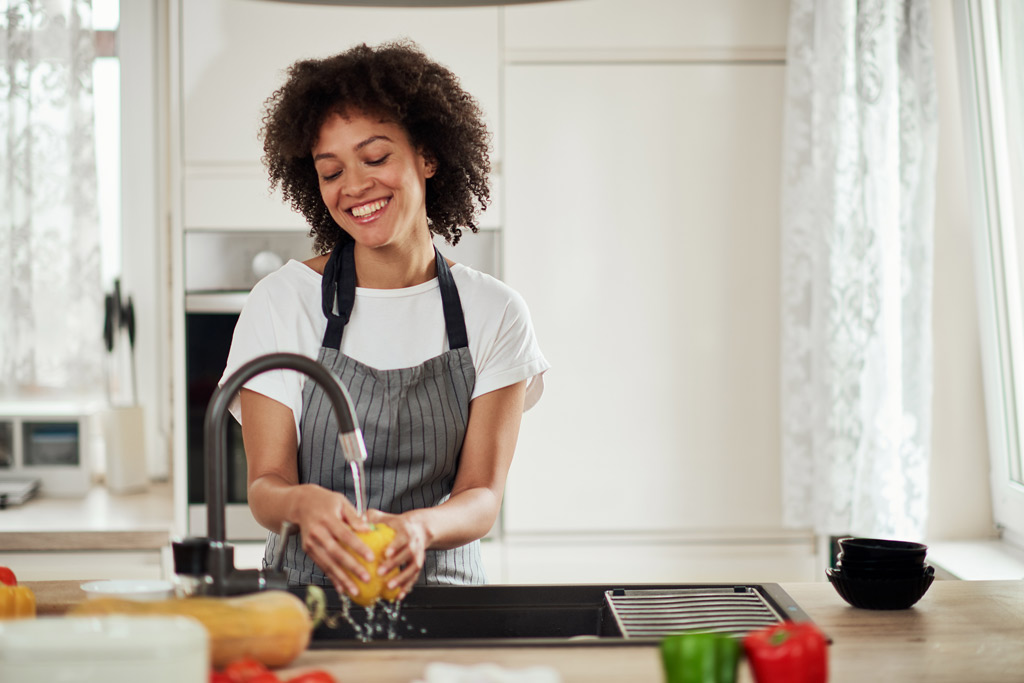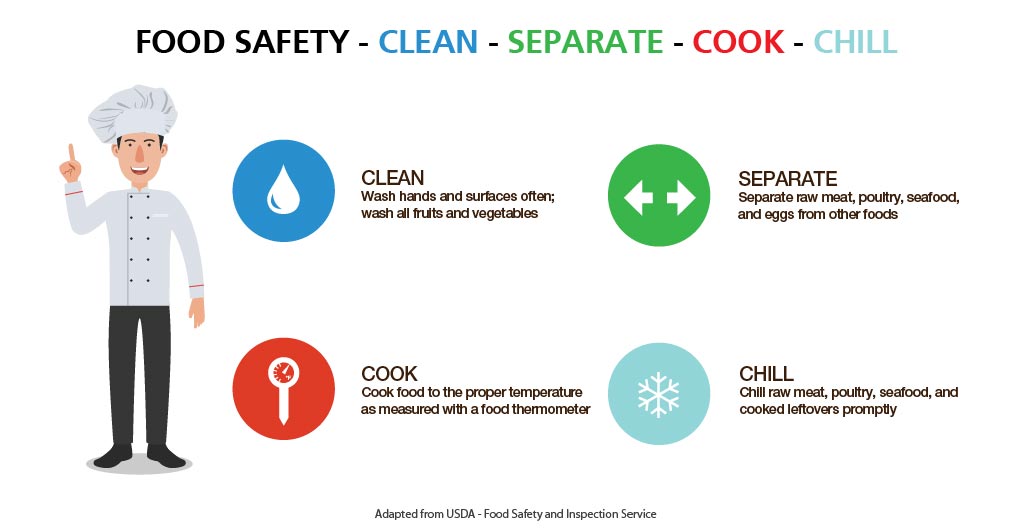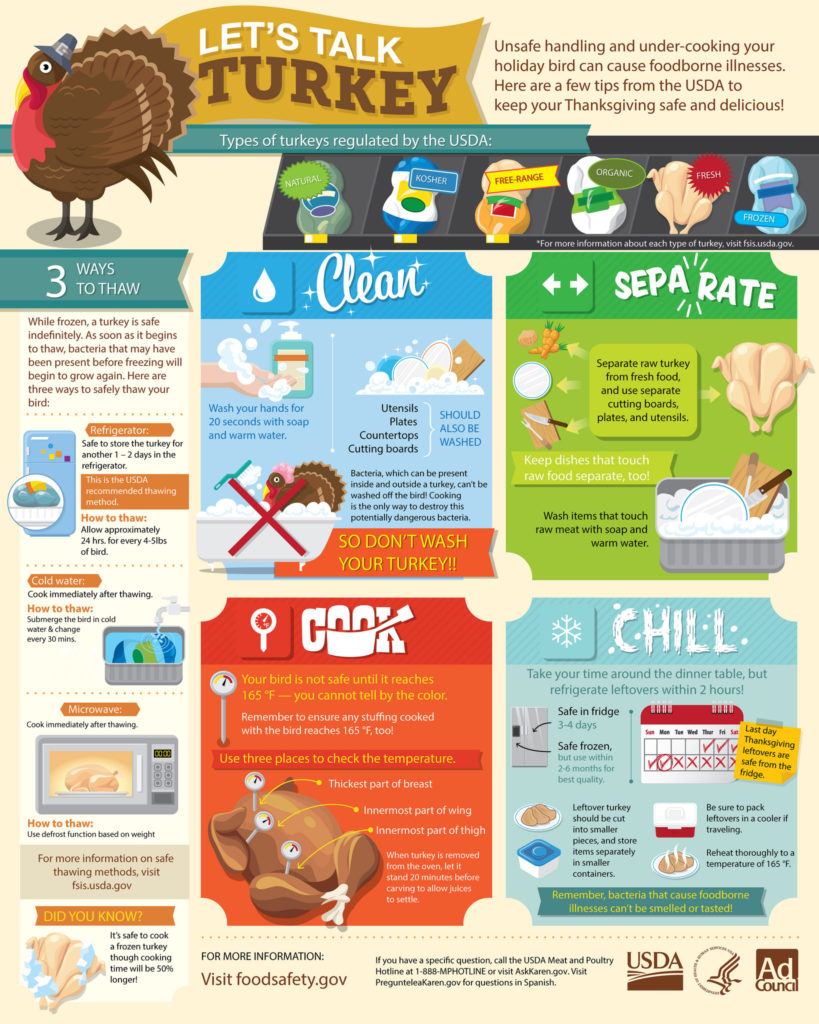Many people think that washing their turkey will remove bacteria and make it safe. However, it’s virtually impossible to wash bacteria off the bird and juices that splash during washing can transfer bacteria onto the surfaces of your kitchen, other foods and utensils. This is called cross-contamination, which can make you and your guests very sick.
Do not wash your turkey in preparation for cooking. It only spreads bacteria onto countertops and other surfaces and your hands. Only cooking the turkey thoroughly to 165°F kills any bacteria that might be present.



Don’t Wash the Raw Turkey
According to a food-safety survey conducted by the FDA, 68% of people wash a whole turkey before cooking it.
The USDA does not recommend washing raw meat and poultry before cooking because it can spread bacteria up to 3 feet around the sink. This animation from New Mexico State University demonstrates the danger of spreading the bacteria when washing a turkey.
Hand Washing – Preventing Cross Contamination
Washing your hands before and after handling a turkey and its packaging is crucial to avoid spreading harmful bacteria. Be sure to wash your hands with warm water and soap for 20 seconds. This simple, but important step can help keep you and your guests safe from foodborne illness.
- Learn about proper hygiene, cross contamination, cold and hot food safety, foodborne pathogens, and best practices to prevent foodborne illness.
- Food Manager Training & ANSI Certification - $99.00
- Food Handler Training - only $7.00!
- HACCP Training: 16hr/4hr/1hr
- Food Allergy Training - $15.00
- Enter Promo "train10off" at Checkout
If raw turkey or its juices come in contact with kitchen surfaces, wash the counter tops and sinks with hot, soapy water. For extra protection, surfaces should be sanitized with a solution of 1 tablespoon of liquid chlorine bleach per gallon of water. Be sure to let those areas dry thoroughly.



Basic Food Safety Turkey Tips
To avoid making everyone at the table sick, the USDA Food Safety and Inspection Service (FSIS) offers basic tips for a food safe Thanksgiving:



Safe Preparation: Don’t Wash the Turkey
The USDA does not recommend washing raw meat and poultry before cooking. Washing raw meat and poultry can cause bacteria to spread up to three feet away. Cooking (baking, broiling, boiling, frying or grilling) meat and poultry to the right temperature is the only method to kill bacteria.
Safe Preparation: Defrosting or Thawing the Frozen Turkey
Thawing turkeys must be kept at a safe temperature. The “danger zone” is between 40°F and 140°F — the temperature range where foodborne bacteria multiply rapidly. While frozen, a turkey is safe indefinitely, but as soon as it begins to thaw, bacteria that may have been present before freezing can begin to grow again, if it is in the “danger zone.”
There are three safe ways to thaw food: in the refrigerator, in cold water, and in a microwave oven.
1. Refrigerator Thawing
When thawing a turkey in the refrigerator:
- Plan ahead: allow approximately 24 hours for each 4 to 5 pounds in a refrigerator set at 40 °F or below.
- Place the turkey in a container to prevent the juices from dripping on other foods.
Refrigerator Thawing Times – Whole turkey:
- 4 to 12 pounds — 1 to 3 days
- 12 to 16 pounds — 3 to 4 days
- 16 to 20 pounds — 4 to 5 days
- 20 to 24 pounds —5 to 6 days
A thawed turkey can remain in the refrigerator for 1 or 2 days before cooking. Foods thawed in the refrigerator can be refrozen without cooking but there may be some loss of quality.
2. Cold Water Thawing
Allow about 30 minutes per pound.
First be sure the turkey is in a leak-proof plastic bag to prevent cross-contamination and to prevent the turkey from absorbing water, resulting in a watery product.
Submerge the wrapped turkey in cold tap water. Change the water every 30 minutes until the turkey is thawed. Cook the turkey immediately after it is thawed.
Cold Water Thawing Times
- 4 to 12 pounds — 2 to 6 hours
- 12 to 16 pounds — 6 to 8 hours
- 16 to 20 pounds — 8 to 10 hours
- 20 to 24 pounds — 10 to 12 hours
A turkey thawed by the cold water method should be cooked immediately. After cooking, meat from the turkey can be refrozen.
3. Microwave Thawing
Follow the microwave oven manufacturer’s instruction when defrosting a turkey. Plan to cook it immediately after thawing because some areas of the food may become warm and begin to cook during microwaving. Holding partially cooked food is not recommended because any bacteria present wouldn’t have been destroyed.
A turkey thawed in the microwave must be cooked immediately.
Clean Thoroughly: Prevent Cross-Contamination
Bacteria present on raw poultry can contaminate your hands, utensils, and work surfaces as you prepare the turkey. If these areas are not cleaned thoroughly before working with other foods, bacteria from the raw poultry can then be transferred to other foods. After working with raw poultry, always wash your hands, utensils, and work surfaces before they touch other foods.
Safe Cooking: Use a Meat Thermometer
The only way to destroy bacteria on your turkey is to cook it to a safe minimum internal temperature of 165°F as measured with a food thermometer. Some chefs prefer to cook to a higher temperature for flavor and texture.
Remember to check the turkey’s temperature in the innermost part of the thigh and wing, and the thickest part of the breast to be sure it is free of illness-causing bacteria.
Safe Leftovers: Store Properly
Portion the turkey and refrigerate it as soon as you can, within two hours of the turkey coming out of the oven. Leftovers will only last for four days in the refrigerator, so if you know you won’t use them right away, pack them into freezer bags or airtight containers and freeze.
For best quality, use your leftover turkey from the freezer within four months. After that, the leftovers will still be safe, but can dry out or lose flavor.
Safe Stuffing
For optimal safety and uniform doneness, cook the stuffing outside the turkey in a casserole dish. However, if you place stuffing inside the turkey, do so just before cooking, and use a food thermometer. Make sure the center of the stuffing reaches a safe minimum internal temperature of 165°F. Bacteria can survive in stuffing that has not reached 165°F, possibly resulting in foodborne illness.



Have a Food Safe Happy Thanksgiving!
Additional Turkey Food Safety Resources
- Let’s Talk Turkey Brochure (PDF)
- USDA – Thanksgiving Toolkit to Prevent Foodborne Illness
- Poultry Preparation – USDA
- Let’s Talk Turkey: A Consumer Guide to Safely Roasting a Turkey – USDA
- Turkey Basics: Handling Cooked Dinners & Leftovers – USDA
- Turkey Basics: Safe Cooking – USDA, (Spanish language Turkey Basics)
- CDC Foodborne Illness
- CDC Food Safety
- Let’s Talk Turkey Brochure (PDF)






